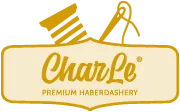Plastic-free elasticity: Elastics suitable for grandchildren for fashion and design
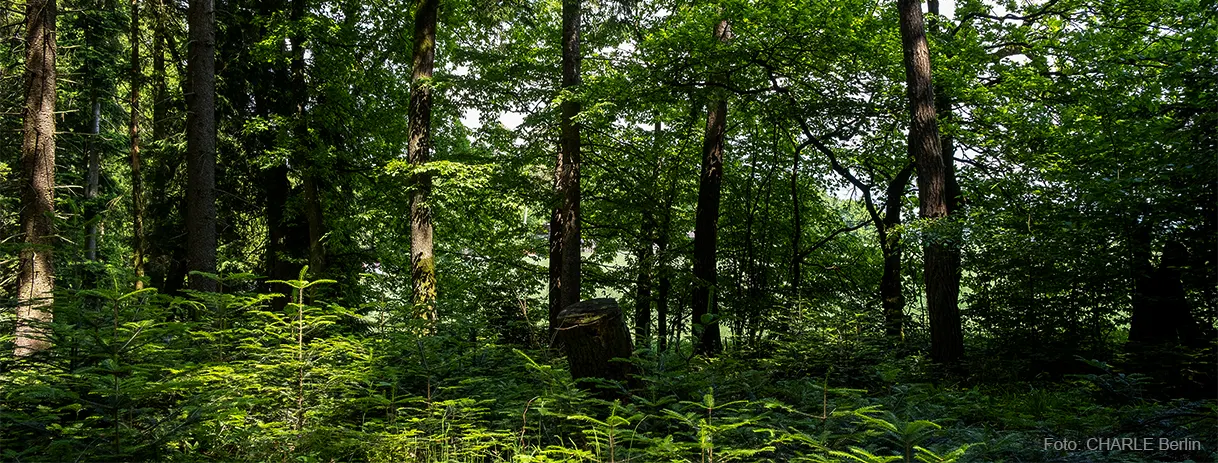
Table of contents:
- Introduction
- The challenge: microplastics and synthetic elastic bands
- Our solution: elastic bands without plastic
- Focus on materials: natural rubber and renewable and bio-based fibres
- Applications in fashion and product design
- Durability, performance and environmental impact
- Advantages for brands and design processes
- Conclusion: Why plastic-free elastic is worth it
- About CHARLE premium haberdashery
- List of abbreviations | Explanations
1. Introduction
What actually holds our world together? On a small scale, it is often the things we hardly notice – an elastic band that holds up our waistband, closes our notebook or protects our sleeve. But behind these everyday helpers lies an ecological problem: conventional elastic bands are made of synthetic rubber and polyester – materials that release microplastics and degrade very slowly.
At CHARLE, we have developed an alternative: elastic bands without plastic, made from natural and bio-based fibres and natural rubber. They are functional, durable and environmentally responsible – suitable for design solutions that are not only aesthetic but also sustainable.
2. The challenge: microplastics and synthetic elastic bands
Elastic bands are invisible standard components in textile and product design. They must be reliably stretchy, durable and dimensionally stable – properties that are often achieved in industry by using synthetic materials such as polyester, polyamide and elastane.
However, these materials have one major drawback: they are made of plastic, which breaks down over time into microplastics that end up in the soil and water through washing or disposal. There they remain for decades or even centuries, damaging ecosystems, entering food chains and posing a growing threat to humans and the environment. 1
For companies and designers who want to choose more sustainable materials, this poses a challenge: how can you maintain elasticity without using plastic?
In addition, the fashion and textile sector is increasingly under scrutiny: consumers, legislators and partners along the supply chain are demanding transparent, environmentally friendly solutions that are also visible in the small, hidden components of a product. Elastic bands often only come into focus at a late stage – yet they are a crucial piece of the puzzle for true sustainability.
3. Our solution: elastic bands without plastic
Our elastic bands are based on a simple but effective principle: function and sustainability are not mutually exclusive. Instead of synthetic yarns and industrial rubber, we use natural rubber as the elastic core and organic and bio-based fibres as the outer layer. The result is a stretchy band that is completely free of plastic – yet performs just as reliably as conventional products.
The development of these tapes requires careful material selection, technical expertise and a keen sense of textile properties. At CHARLE, we combine this expertise with a clear commitment: every product must not only be environmentally and socially responsible, but also practical and aesthetically appealing.
UOur ribbons are suitable for a wide range of applications in fashion and product design – wherever elasticity is required but microplastics are undesirable. They can be sewn, fixed, edged or used decoratively – much like conventional elastic, only better for people and the environment.
We thus offer designers, product developers and sustainability managers an alternative that requires no compromise – but opens up new creative and communicative possibilities.
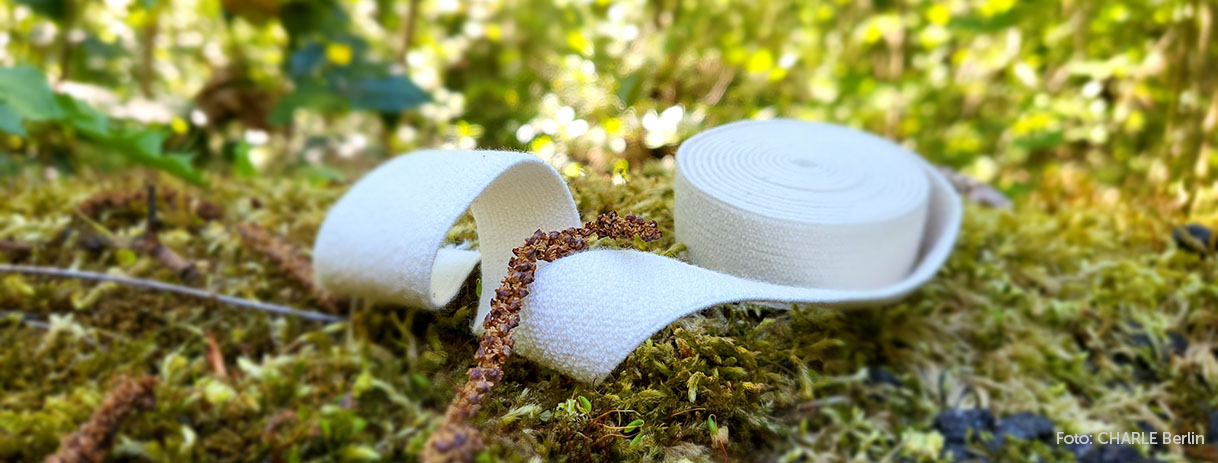
4. Focus on materials: natural rubber and renewable and bio-based fibres
The quality and environmental compatibility of our elastic bands begins with the raw material. We use certified natural rubber (FSC®, REACH, OEKO-TEX® STANDARD 100) as the elastic element – obtained from the milk sap of the rubber tree (Hevea brasiliensis), which is completely recyclable. Although talc (naturally occurring magnesium silicate) is used in small quantities as a technical additive for coating the rubber threads, this does not affect the recyclability of the product. Unlike synthetic rubber, which is petroleum-based, natural rubber is a renewable raw material with a significantly smaller ecological footprint. 2
For the cover, we use bio-based or organic fibres – depending on the application, these include TENCELTM from Lenzing and cotton (GOTS certified). These fibres are not only pleasant on the skin and visually versatile, but also recyclable. They come from responsible pulp production or controlled sustainable agriculture.
Our choice of materials is guided by three guiding principles:
- Plastic-free – No polyester or polyamide components, either in the core or in the cover
- Circularity – no harmful residues in the environment
- Textile quality – High tear resistance, good sewability, harmonious look and feel
This combination makes our elastic tapes a genuine material of the future – ready for use today.
5. Applications in fashion and product design
Our plastic-free elastic bands are versatile – they can be used anywhere something needs to be held together securely and comfortably. Whether visible or hidden, functional or decorative: elasticity is often the detail that makes a product usable.
In the fashion sector, our ribbons are used in ribbons are used in :
- Waistbands that allow the waist to remain flexible without pressure or stretching
- Underwear and bras, where skin contact, breathability and sustainability play a central role
- Children's clothing, where safety, washability and environmental compatibility are particularly important
- Outdoor and rainwear, e.g. for securing sleeves, trouser legs, hoods
- Accessories such as hair bands or caps that combine form and function
The areas of application are also diverse in product design:
- Textile notebook closures that are reusable and stylish
- Packaging that combines functionality and environmental friendliness
- Home textiles, e.g. elastic bands for covers, seat cushions or toys
Thanks to their natural feel, high elasticity and durability, our ribbons offer designers a genuine alternative to synthetic elastic ribbons – both in terms of functionality and aesthetics.
They open up new possibilities for holistically sustainable products – from the visible exterior to the innermost detail.
6. Durability, performance and environmental impact
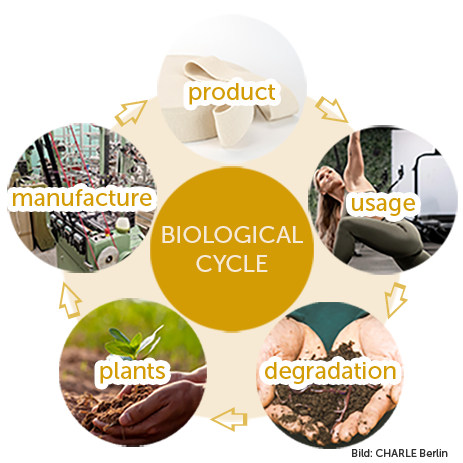
Sustainability is not just about what a product contains – it's also about how long it lasts. Our elastic tapes combine high material quality with long-lasting performance. They retain their elasticity, are tear-resistant, dimensionally stable and can be easily integrated into standard manufacturing processes.
In practice, this means:
- No rapid wear and tear
- No loss of quality due to frequent washing
- No loss of function due to natural material ageing
Despite their biological recyclability, our tapes are not short-lived. They are designed to fulfil their function throughout the entire service life of a garment or product – and only then, in the right environment, do they completely decompose. They therefore meet a key sustainability criterion: they do not harm the environment – either during use or after disposal.
A comparison with conventional elastic bands shows:
- No microplastic abrasion during washing
- No fossil raw materials
- No problematic hazardous waste after use
Our elastic bands contribute to circular textile design. They enable designers to develop products that not only look good and function well, but are also well made in an ecological sense.
7. Advantages for brands and design processes
The decision to use plastic-free, elastic bands often seems like a small detail at first glance – but it sends a strong signal. For brands that want to take responsibility, using our bands offers several advantages:
-
Sustainability down to the last detail
Many textile products today are already made from recycled or natural materials. However, it is often the invisible components – such as elastics – that remain synthetic. Our tapes close this gap and enable consistent product design without compromise. -
Differentiation through material expertise
Designs that use plastic-free elastic stand out thanks to their thoughtful choice of materials and environmental awareness. This attitude can be communicated to the outside world, whether on hang tags, in the material story or in the sustainability report. -
Communication & certification support
Our materials are traceable and certifiable. Upon request, we provide information on origin and composition to support B2B communication, certification processes or brand storytelling. -
Quality that impresses – even in skilled trades
Our tapes can be integrated into standard production processes. They are sewable, largely cut-resistant, dimensionally stable and visually appealing. This facilitates cooperation with manufacturers and workshops – and creates confidence in the choice of material. -
Positive impact on the environment and image
Sustainable products not only strengthen your ecological footprint, but also the credibility of your brand. More and more consumers are questioning the entire supply chain – with our ribbons, you can show that sustainability is not a trend, but standard. See also our test results on the composting of one of our elastic products.
8. Conclusion: Why plastic-free elastic is worth it
Sustainability often starts small – in hidden seams, barely visible edges and functional details. These are the areas that determine whether a product is truly future-proof.
Our plastic-free, elastic tapes combine functionality with responsibility. They meet the highest standards in everyday use, in the design process and in manufacturing – while also enabling an important step towards a recyclable, low-pollutant and plastic-free textile world.
For fashion designers and product developers, they represent a real expansion of their creative repertoire. For sustainability officers, they are a concrete contribution to improving material balances and product claims.
Anyone developing textile products today should also consider the elastic components – because they contribute to what drives our society: fashion, function and responsibility.
9. About CHARLE premium haberdashery
CHARLE was founded in 2010 with the vision of creating a more sustainable fashion world. Starting out as CHARLE sustainable kids fashion, an eco-friendly children's fashion label, we have always focused on creating textiles and accessories that are not only functional and beautiful, but also sustainable. Our high sense of responsibility is underpinned by GOTS and Grüner Knopf certifications.
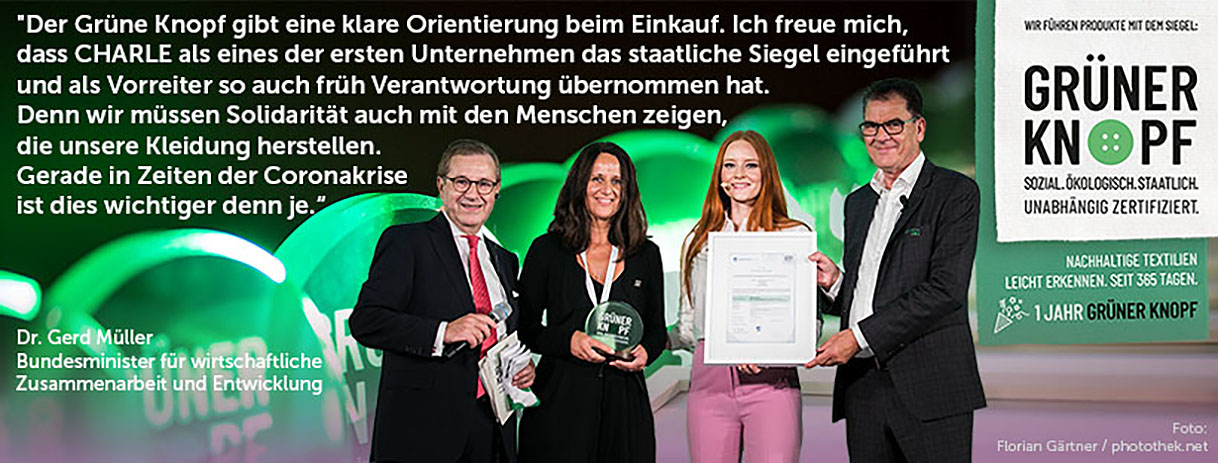
In 2011, we developed our first organic elastic – initially for our own use. It was the beginning of a product line that now includes a comprehensive range of plastic-free elastic bands that can be used in fashion, product design and many other areas.
Our philosophy is simple: sustainability must be practical and aesthetically appealing without compromising on quality. With this approach, we offer our customers not only innovative materials, but also comprehensive consulting services, tailor-made solutions and worldwide shipping with independent export customs clearance. We prefer long-term, partnership-based relationships and work closely with companies to develop tailor-made, sustainable textile solutions.
At CHARLE, we believe that every detail matters – and that it's never too late to steer the textile world in a more sustainable direction.
10. Abkürzungsverzeichnis | Erläuterungen
| Abbreviation | Explanation |
|---|---|
| CHARLE | A made-up word composed of the first letters of the first names of the founder's children. |
| Suitable for grandchildren | Means that something is designed in such a way that it will still be liveable, usable and meaningful for future generations. |
| FSC® | The Forest Stewardship Council® is an international certification system for more sustainable forest management. |
| REACH | REACH stands for Registration, Evaluation, Authorisation and Restriction of Chemicals (Regulation (EC) No. 1907/2006 = EU Chemicals Regulation). |
| OEKO-TEX® STANDARD 100 | OEKO-TEX® STANDARD 100 is an independent testing and certification system for textiles and accessories that guarantees consumers protection from harmful substances. |
| GOTS | GOTS stands for Global Organic Textile Standard and is an internationally recognised standard for the processing of textiles made from organically grown natural fibres. |
| Grüner Knopf | The Green Button is a government seal awarded by the German federal government for socially and ecologically produced textiles. |
| TENCEL™ | TENCEL™ is a brand name of Lenzing AG for the textile fibre Lyocell, an industrially produced regenerated cellulose. |
| Plastic-free | According to: Directive (EU) 2019/904 |
